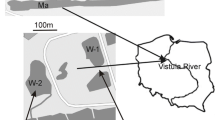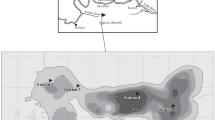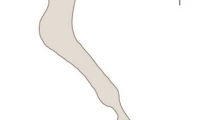Abstract
Phytoplankton biomass, morphological and taxonomic composition, species diversity and productivity were analyzed in a shallow lake of the Middle Paraná River floodplain (El Tigre, 31 ° 41′ S and 60° 42′ W), between November 1986 and July 1988. Lake inundation (filling and through-flow phases) constituted an intense long-term perturbation in the physical and chemical environment. As the lake filled with river water, K-selected species (netplanktonic filamentous bluegreens, > 37 µm, with low surface area/volume (SA/V) ratios) that had existed prior to filling (late spring 1986) were replaced in summer-fall by r-selected species (nannoplanktonic chlorophytes and cryptophytes, < 37 µm, mainly stout forms with high SA/V ratios). During the through-flow phase, lentic phytoplankton was replaced by lotic flagellate populations due to the direct flushing by river water. During the period of falling water (drainage and isolation phases), nanoplanktonic algae with similar characteristics to those of the filling phase dominated in late winter-spring. Later in the isolation phase, these were succeeded by K-selected species (netplanktonic algae, mainly motile spherical dinoflagellates and filamentous bluegreens with low SA/V ratios). Simultaneously, primary production per unit biomass decreased and total biomass and specific diversity increased. Seasonal changes of phytoplankton in floodplain lakes can be interpreted as the interaction between true successional development (as observed in the drainage and isolation phases) and intermediate disturbance. Using Reynolds' terminology, short-term disturbance (slight inflow of nutrient-rich river water) caused ‘reversion’ to an earlier stage in the former succession, and long-term disturbance (lake inundation) truncated the successional progression and a new (or ‘shifted’) succession was initiated.
Similar content being viewed by others
References
APHA, 1985. Standard methods for the examination of water and wastewater. APHA, ANWA & WPCF, Washington, 874 pp.
Bailey-Watts, E. E., 1986. Seasonal variation in size spectra of phytoplankton assemblages in Loch Leven. In: M. Munawar & J. F. Talling (eds), Seasonality of Freshwater Phytoplankton. Developments in Hydrobiology 33. Dr W. Junk Publishers, Dordrecht: 25–42. Reprinted from Hydrobiologia 138.
Drago, E., 1989. Morphological and hydrological characteristics of the floodplain ponds of the Middle Paraná River (Argentina). Rev. Hydrobiol. trop. 22 (3): 183–190.
Esteves, F., 1988. Fundamentos de Limnologia. Interciencia, Rio de Janeiro, 575 pp.
Garciá de Emiliani, M. O., 1990a. Phytoplankton ecology of the Middle Paraná River. Acta Limnol. Brasil. 3: 391–417.
García de Emiliani, M. O., 1990b. Variaciones diurnas del fito plancton (laguna ‘El Tigre’, Ilanura aluvial del Paraná Medio, Argentina). Rev. Asoc. Cienc. Nat. Litoral 21: 49–60.
González, H., S. Pantoja, J. L. Iriarte & P. A. Bernal, 1989. Winter-spring variability of size fractioned autotrophic biomass in Concepcin Bay, Chile. J. Plankton Res. 11: 1157–1161.
Hamilton, S. & W. Lewis Jr., 1987. Causes of seasonality in the chemistry of a lake on the Orinoco River floodplain, Venezuela. Limnol. Oceanogr. 32: 1277–1290.
Hamilton, S. & W. Lewis Jr., 1990. Basin morphology in relation to chemical and ecological characteristics of lakes on the Orinoco River floodplain, Venezuela. Arch. Hydrobiol. 119 (4): 393–425.
Harris, G. H., 1986. Phytoplankton ecology: structure, function and fluctuation. Chapman & Hall, London, 384 pp.
Harris, G. P., B. B. Piccinin & J. Van Ryn, 1983. Physical variability and phytoplankton communities. 5. Cell size, niche diversification and the role of competition. Arch. Hydrobiol. 98: 215–239.
Jones, J. G., 1979. A guide to methods for estimating microbial numbers and biomass in freshwater. Scient. Publs. Freshwat. biol. Ass. 39: 1–107.
Jordan, I. T., P. E. Ross & B. Pinel-Alloul, 1988. Seasonal variations in phytoplankton size structure in Lake Cromwell (Laurentian Shield), Quebec. Hydrobiologia 169: 167–182.
Kalff, J., 1972. Net plankton and nanoplankton production and biomass in a North temperate zone lake. Limnol. Oceanogr. 17: 712–720.
Lacroix, G., P. Boet, J. Garnier, F. Lescher-Moutoué, R. Pourriot & P. Testard, 1989. Factors controlling the planktonic community in the shallow Lake of Créteil, France. Int. Revue ges. Hydrobiol. 74 (4): 353–370.
Lewis, W. M. Jr., 1978. Dynamics and succession of the phytoplankton in a tropical lake. J. Ecol. 66: 849–880.
Lewis, W. M. Jr., 1986. Phytoplankton succession in Lake Valencia, Venezuela. In: M. Munawar & J. F. Talling (eds), Seasonality of Freshwater Phytoplankton. Developments in Hydrobiology 33. Dr W. Junk Publishers, Dordrecht: 189–203. Reprinted from Hydrobiologia 138.
Lund, J. W. G., C. Kipling & E. D. Le Cren, 1958. The inverted microscope method of estimating algal numbers and the statistical basis of estimations by counting. Hydrobiologia 2: 143–170.
Margalef, R., 1958. Temporal succession and spatial heterogeneity in phytoplankton. In A. A. Buzzati-Traverso (ed.), Perspective in marine biology. Univ. of Calif. Press, Berkeley (Calif.): 323–349.
Margalef, R., 1968. Perspectives in ecological theory. Univ. of Chicago Press, Chicago, 111 pp.
Margalef, R., 1978. Life-forms of phytoplankton as survival alternatives in an unstable environment. Oceanologia Acta. 1: 493–509.
Munawar, M. & I. F. Munawar, 1986. The seasonality of phytoplankton in the North American Great Lakes, a comparative synthesis. In: M. Munawar & J. F. Talling (eds), Seasonality of Freshwater Phytoplankton. Developments in Hydrobiology 33. Dr W. Junk Publishers, Dordrecht: 85–115. Reprinted from Hydrobiologia 138.
Odum, E. P., 1969. The strategy of ecosystem development. Science 164: 262–270.
Odum, E. P., 1971. Fundamentals of ecology. W.B. Saunders Co., Philadelphia, 574 pp.
Olrik, K., 1981. Succession of phytoplankton in response to environmental factors in lake Arreso, North Zealand, Denmark. Schweiz. Z. Hydrol. 43: 6–19.
Pick, F. R. & D. A. Caron, 1987. Picoplankton and nanoplankton biomass in Lake Ontario: relative contribution of phototrophic and heterotrophic communities. Can. J. Fish. aquat. Sci. 44: 2164–2172.
Pridmore, R. D., J. E. Hewitt & A. B. Cooper, 1989. Does chorophyll a content of phytoplankton vary with trophic status in lakes on the New Zealand central volcanic plateau? J. Plankton Res. 11: 583–593.
Reynolds, C. S., 1980. Phytoplankton assemblages and their periodicity in stratifying lake systems. Holarct. Ecol. 3: 141–159.
Reynolds, C. S., 1984. The ecology of freshwater phytoplankton. Cambridge Univ. Press, London, 384 pp.
Reynolds, C. S., 1988. The concept of ecological succession applied to seasonal periodicity of freshwater phytoplankton. Verh. Internat. Verein. Limnol. 23: 683–691.
Reynolds, C. S., S. W. Wiseman & J. O. Clarke, 1984. Growth- and loss-rate responses of phytoplankton to intermittent artificial mixing and their potential application to the control of plankton algal biomass. J. appl. Ecol. 21: 11–39.
Rott, E., 1981. Some results from phytoplankton counting intercalibrations. Schweitz Z. Hydrol. 43: 34–61.
Round, F. E., 1971. The growth and succession of algal populations in freshwaters. Mitt. int. Ver. Limnol. 19: 70–79.
Shannon, C.E. & W. Weaver, 1963. The mathematical theory of communication. Univ. Illinois Press, Urbana, 117 pp.
Sommer, U., 1985. Seasonal succession of phytoplankton in Lake Constance. BioScience 35 (6): 351–357.
Sommer, U. (ed.), 1989. Plankton ecology: succession in plankton communities. Springer-Verlag, Berlin, 369 pp.
Sommer, U., Z. M. Gliwicz, W. Lampert & A. L. Duncan, 1986. The PEG-model of seasonal succession of plankton events in fresh waters. Arch. Hydrobiol. 106: 433–471.
Talling, J. F., 1986. The seasonality of phytoplankton in African lakes. In: M. Munawar & J.F. Talling (eds), Seasonality of Freshwater Phytoplankton. Developments in Hydrobiology 33. Dr W. Junk Publishers, Dordrecht: 139–160. Reprinted from Hydrobiologia 138.
Uehlinger, U. & J. Bloesch, 1989. Primary production of different phytoplankton size classes in an oligo-mesotrophic Swiss lake. Arch. Hydrobiol. 116: 1–21.
Utermohl, H., 1958. Zur Vervollkommnung der quantitativen Phytoplankton-Methodik. Mitt. int. Ver. Limnol. 9: 1–38.
Vollenweider, R. A., 1974. A manual on methods for measuring primary production in aquatic environments. 2nd edn. IBP Handbook n° 12. Blackwell, Oxford, 25 pp.
Witek, Z. & A. Krajewska-Soltys, 1989. Some examples of the epipelagic plankton size-structure in high latitude oceans. J. Plankton Res. 11: 1143–1155.
Author information
Authors and Affiliations
Rights and permissions
About this article
Cite this article
Garciá de Emiliani, M.O. Seasonal succession of phytoplankton in a lake of the Paraná river floodplain, Argentina. Hydrobiologia 264, 101–114 (1993). https://doi.org/10.1007/BF00014097
Received:
Revised:
Accepted:
Issue Date:
DOI: https://doi.org/10.1007/BF00014097




